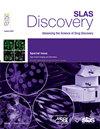Cell based high-throughput screening for small molecule inhibitors of ATE1
IF 2.7
4区 生物学
Q2 BIOCHEMICAL RESEARCH METHODS
引用次数: 0
Abstract
Arginyltransferase 1 (ATE1) catalyzes post-translational arginylation, a process implicated in protein stability, cellular function, and disease pathology. Dysregulated arginylation is associated with neurodegenerative disorders, cancer, and inflammation. Particularly, the increase of ATE1 activity has been shown to cause cell death in response to acute stress, highlighting ATE1 as a promising therapeutic target. Despite its therapeutic relevance, no selective small-molecule inhibitors of ATE1 have been FDA-approved at this time, with previous screening efforts yielding compounds with high promiscuity and toxicity. This, in part, is due to the lack of assays that would accommodate large-scale screening for effective and safe ATE1-inhibitors. To address this challenge, we developed a cell-based high-throughput screening (HTS) assay utilizing a fluorescent reporter system based on an ATE1 substrate peptide fused to a fluorescence protein and co-expressed alongside another fluorescence protein for normalization. The assay enables real-time quantification of ATE1 activity by monitoring arginylation-dependent protein degradation within intact cells, measured by the ratio of the two fluorescence signals. We validated the assay in 96-well and 1536-well plate formats, demonstrating its scalability and robustness through key performance metrics, including Z'-factor and signal-to-background ratio. A pilot screen of a Library of Pharmacologically Active Compounds (LOPAC®1280) was performed to evaluate this approach. This study establishes a scalable and selective platform for discovering ATE1 inhibitors, paving the way for future therapeutic development targeting ATE1-mediated disease pathways.
基于细胞的高通量筛选ATE1小分子抑制剂。
精氨酸基转移酶1 (ATE1)催化翻译后精氨酸化,这一过程涉及蛋白质稳定性、细胞功能和疾病病理。精氨酸化失调与神经退行性疾病、癌症和炎症有关。特别是,ATE1活性的增加已被证明会导致细胞在急性应激反应中死亡,这表明ATE1是一个有希望的治疗靶点。尽管ATE1具有治疗意义,但目前fda还没有批准ATE1的选择性小分子抑制剂,之前的筛选工作产生了高混杂性和毒性的化合物。这在一定程度上是由于缺乏适合大规模筛选有效和安全的ate1抑制剂的检测方法。为了解决这一挑战,我们开发了一种基于细胞的高通量筛选(HTS)试验,利用荧光报告系统,该系统基于ATE1底物肽与荧光蛋白融合,并与另一种荧光蛋白共同表达以进行标准化。该分析通过监测完整细胞内精氨酸依赖蛋白的降解,通过两个荧光信号的比率来测量ATE1活性的实时定量。我们在96孔和1536孔平板格式中验证了该分析方法,通过关键性能指标(包括Z因子和信本比)证明了其可扩展性和稳健性。对药理学活性化合物库(LOPAC®1280)进行了试点筛选以评估该方法。该研究为发现ATE1抑制剂建立了一个可扩展和选择性的平台,为未来针对ATE1介导的疾病途径的治疗开发铺平了道路。
本文章由计算机程序翻译,如有差异,请以英文原文为准。
求助全文
约1分钟内获得全文
求助全文
来源期刊

SLAS Discovery
Chemistry-Analytical Chemistry
CiteScore
7.00
自引率
3.20%
发文量
58
审稿时长
39 days
期刊介绍:
Advancing Life Sciences R&D: SLAS Discovery reports how scientists develop and utilize novel technologies and/or approaches to provide and characterize chemical and biological tools to understand and treat human disease.
SLAS Discovery is a peer-reviewed journal that publishes scientific reports that enable and improve target validation, evaluate current drug discovery technologies, provide novel research tools, and incorporate research approaches that enhance depth of knowledge and drug discovery success.
SLAS Discovery emphasizes scientific and technical advances in target identification/validation (including chemical probes, RNA silencing, gene editing technologies); biomarker discovery; assay development; virtual, medium- or high-throughput screening (biochemical and biological, biophysical, phenotypic, toxicological, ADME); lead generation/optimization; chemical biology; and informatics (data analysis, image analysis, statistics, bio- and chemo-informatics). Review articles on target biology, new paradigms in drug discovery and advances in drug discovery technologies.
SLAS Discovery is of particular interest to those involved in analytical chemistry, applied microbiology, automation, biochemistry, bioengineering, biomedical optics, biotechnology, bioinformatics, cell biology, DNA science and technology, genetics, information technology, medicinal chemistry, molecular biology, natural products chemistry, organic chemistry, pharmacology, spectroscopy, and toxicology.
SLAS Discovery is a member of the Committee on Publication Ethics (COPE) and was published previously (1996-2016) as the Journal of Biomolecular Screening (JBS).
 求助内容:
求助内容: 应助结果提醒方式:
应助结果提醒方式:


